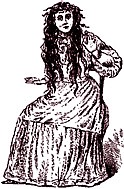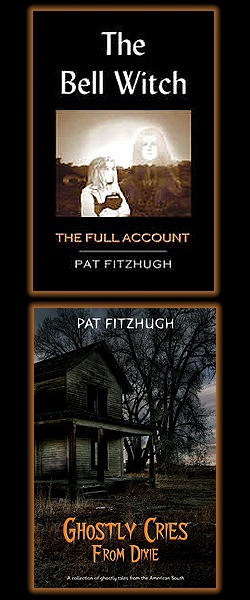The Bell Witch Site
Recommended Books
The Bell Witch SiteOn Social Media The
Bell Witch Site | Copyright © 1995
- 2025 Pat Fitzhugh On Social Media
Pat Fitzhugh's Official Web Site
|
Bell Witch Character Biography
Joel Bell (1813-1890)
The youngest child of John and Lucy Bell, Joel Egbert Bell was born at the Bell farm in Robertson County, Tennessee and spent his childhood and many of his adult years in the area. Although too young to remember many details of the disturbances, Joel Bell later became knowledgeable by listening to his mother and siblings tell of the remarkable encounters and torment they suffered at the hands of Kate.
After the original Bell home was razed, Joel Bell used some of its logs and stones to build his home on Brown’s Ford Bluff, a hill overlooking the Red River less than a half-mile away. He moved to nearby Springfield about 1855, selling the house to Richard Williams Bell, who in turn left it to his son, State Rep. Allen Bell, upon his death in 1857. A number of strange events occurred in this house, two of which are related below:
In the winter of 1852, Dr. Henry Sugg experienced an incident where the vials in his medicine bag shook and rattled as he tended to a sick child at the house. He often wrote and spoke of the incident, attributing it to none other than Kate. In 1861, Allen Bell was discharged from the Confederate Army due to illness. [1] While recuperating, he was visited at this house by another soldier, Leftrick Reynolds Powell, son of Elizabeth and Richard Powell. The two men reported strange noises being heard in the kitchen part of the house and on the grounds outside. The dog became hysterical and "fought" against an unseen force until the wee hours of the next morning.
Bell moved his family to nearby Springfield in 1855, where he spent the remainder of his life as a successful farmer and well-respected citizen. Along the way, he cultivated a friendship with Martin Ingram, future author of the fictitious “Authenticated History of the Bell Witch,” and undoubtedly gave him much insight into the mystery. He married twice and had fourteen children, and died in 1890. He is buried in Adams, Tennessee.
[1] James Allen Bell was discharged from the Confederate Army on May 4, 1862 at Cumberland Gap, due to physical disability. He was a Justice of the Peace (1860), president of the Robertson County Agricultural and Mechanics Association (1872), and served in the Tennessee House of Representatives, representing Robertson County in the 39th General Assembly (1875-1877). See: Microcopy, TN Confederate Service Records, roll 159. See also: Albert Virgil Goodpasture, Goodspeed History of Tennessee – Robertson County, 1886, p. 1129.



